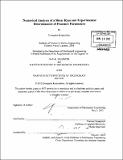Numerical analysis of a shear ram and experimental determination of fracture parameters
Author(s)
Koutsolelos, Evangelos
DownloadFull printable version (29.62Mb)
Other Contributors
Massachusetts Institute of Technology. Dept. of Mechanical Engineering.
Advisor
Tomasz Wierzbicki.
Terms of use
Metadata
Show full item recordAbstract
The human, economic and environmental disaster that followed the Deepwater Horizon catastrophe at the Gulf of Mexico in April 2010 revealed how much the offshore drilling industry relies on the Blowout Preventer (BOP) as the primary means of controlling a 'well kick' or 'blowout'. One of the most important components of the BOP are the shear rams which are tasked with cutting the drilling string in case of an emergency, allowing the blind rams and the annular type blowout preventer to seal the wellbore and generally prevent things from becoming unmanageable. The increased drill pipe material strength, the fact that its diameter and wall thickness are eventually optimized (larger and heavier pipe sizes) and the greater water depths in combination with the high drilling fluid density affect the BOP's ability to shear. This study investigates all stages of the shearing process and attempts to optimize the geometry of the shear blades. In order to do that, simulations are conducted with Finite Element Models (FEM) by utilizing the Impact and Crashworthiness Lab's (ICL) fracture methodology, the backbone of which is the Modified Mohr-Coulomb (MMC) fracture criterion. Nine cases which involve three different angles defining the sharpness (cutting angle) and three angles characterizing the shape of the blades are evaluated. The optimum configurations for the shear blades are investigated based on the maximum required cutting force and the sealing capability. The simulations are performed for the TRIP 690 steel as well as for the X70 grade steel. The fracture and plasticity parameters for the X70 grade steel are experimentally determined in the ICL lab as part of this research. In addition, recommendations for shearing the tool joints, the connections of the drill pipes, are made based on the Finite Element (FE) simulations. Finally, as a second application of the MIT's fracture prediction capability, the process of fracture of a pre-cracked drill pipe is solved numerically and compared with the response of an uncracked drill pipe.
Description
Thesis (Nav. E. and S.M.)--Massachusetts Institute of Technology, Dept. of Mechanical Engineering, 2012. Cataloged from PDF version of thesis. Includes bibliographical references (p. 127-129).
Date issued
2012Department
Massachusetts Institute of Technology. Department of Mechanical EngineeringPublisher
Massachusetts Institute of Technology
Keywords
Mechanical Engineering.